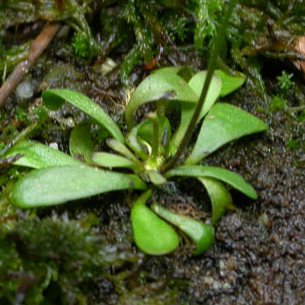Terrestrial herb. Stem short, erect. Leaves usually few, laxly to quite densely rosulate, spathulate, usually long-petiolate, (1)2-4(5) cm x up to 9 mm wide. Traps about as numerous as the leaves. Inflorescence erect, simple or sparsely branched above, (6)10-25(30) cm high; peduncle flexuous, terete, glabrous above, usually sparsely hispidulous at or near the base only; flowers (1)3-10(15); scales few, similar to the bracts; bracts ovate-lanceolate to linear-lanceolate, acute or acuminate, 2-4 mm long, (2)5-15(25) mm long at anthesis, usually elongating in fruit, glabrous throughout or distally hispidulous. Calyx lobes subequal, ovate-lanceolate to lanceolate, acute or acuminate, 2-4 mm long, sparsely to densely hispidulous. Corolla violet, blue, mauve or pink with a greenish or yellowish spur or rarely wholly yellow, (6)10-12(15) mm long; superior lip ovate, about twice as long as the calyx lobes; inferior lip larger, broader than long, 3-lobed; palate raised, gibbous; spur cylindrical, obtuse, 1.5-2 times as long as the inferior lip, more or less hispidulous. Filaments falcate; anther-thecae subdistinct. Ovary ovoid, more or less densely hispidulous; style short, indistinct; stigma inferior lip semi-circular, superior obsolete. Capsule globose to broadly ovoid, 3-4 mm long, more or less densely hispidulous. Seeds numerous, ovoid, 0.4-0.5 mm long, conspicuously reticulate; testa cells more or less isodiametric.
Inflorescence erect, simple or sparsely branched above, (6)10–25(30) cm. high; peduncle flexuous, terete, glabrous above, usually sparsely hispidulous at or near the base only; flowers (1)3–10(15); scales few, similar to the bracts; bracts ovate-lanceolate to linear-lanceolate, acute or acuminate, 2–4 mm. long, (2)5–15(25) mm. long at anthesis, usually elongating in fruit, glabrous throughout or distally hispidulous.
Perennial, carnivorous herb. Leaves dimorphic: foliage leaves rosulate, ± spathulate; trap leaves in substrate, Y-shaped, with stalk, flask-like trap and 2 long, spirally twisted arms. Flowers in terminal racemes 60-300 mm high; violet or blue to pink. Calyx lobes lanceolate, Sub-Equal. Corolla upper lip ovate, 1-or 2-lobed; lower lip spurred, 3-lobed, palate ± gibbous. Flowering time mostly Sept.-Mar.
Corolla violet, blue, mauve or pink with a greenish or yellowish spur or rarely wholly yellow, (6)10–12(15) mm. long; superior lip ovate, about twice as long as the calyx lobes; inferior lip larger, broader than long, 3-lobed; palate raised, gibbous; spur cylindrical, obtuse, 1.5–2 times as long as the inferior lip, more or less hispidulous.
Ovary ovoid, more or less densely hispidulous; style short, indistinct; stigma inferior lip semi-circular, superior obsolete.
Leaves usually few, laxly to quite densely rosulate, spathulate, usually long-petiolate, (1)2–4(5) cm. × up to 9 mm. wide.
Calyx lobes subequal, ovate-lanceolate to lanceolate, acute or acuminate, 2–4 mm. long, sparsely to densely hispidulous.
Similar to the above (Genlisea africana) but lacking the gland-tipped hairs and with fewer, larger leaves.
Seeds numerous, ovoid, 0.4–0.5 mm. long, conspicuously reticulate; testa cells more or less isodiametric.
Capsule globose to broadly ovoid, 3–4 mm. long, more or less densely hispidulous.
Filaments falcate; anther-thecae subdistinct.
Traps about as numerous as the leaves.
Stem short, erect.
Terrestrial herb.


